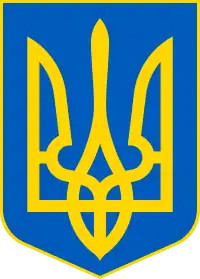Sandal (Utrigur hükümdarı)
Sandal ya da Sandilch (Σάνδιλ, Σάνδιλχος; Türkçe-Memlûk "su aracı/tekne"), 6. yüzyıl Utrigur Bulgar Hunlarının kabile şefidir.[1][2] İsmin kökeni muhtemelen Türkçedir.[3][4] Başlangıçta akraba halk Kutrigurlara karşı bir savaşta Utrigurlara liderlik etmeyi istememişti, Bizans İmparatoru I. Justinianus (h. 527-565) diplomatik ikna ve rüşvet ile onu savaşmaya ikna etti.[5][6] Sandal liderliğindeki Utrigurlar, Kutrigurlara saldırdı ve büyük kayıplar vermelerine neden oldular.[5][6]
| Ukrayna tarihi |
 Bu madde bir dizinin parçasıdır |
|
|
|
Kazaklar
|
|
Erken Çağdaş Dönem
|
|
Erken Yirminci Yüzyıl
|
|
|
Diğer konular
|
Sandal'ın kendi sözleriyle:
| “ | sadece bir dili konuştuğumuz değil, bizimkine benzeyen, komşularımız olan ve aynı giyinme ve yaşam tarzlarına sahip olduğumuz, aynı zamanda akrabalarımız olan, sadece farklı bir hükümdara tabii olan kabileleri (Kutrigurlar) imha etmek adaletten ve nezaketten uzaktır.[7] | ” |
Birbirlerini kırdıktan sonra, Zabergan ve Sandal'ın Bulgarlarının kalanları, İmparator Mauricius (h. 582-602) döneminde Daçya'yı elde etmişlerdir.
Mirası
Antarktika'da bulunan Sandilch zirvesine onun adı verilmiştir.
Ayrıca bakınız
Kaynakça
- Özel
- "The Huns, Rome and the Birth of Europe", Hyun Jin Kim, page 256: " Thus in our sources the names Kutrigur, Bulgar and Hun are used interchangeably and refer in all probability not to separate groups but one group.", page 254: "That the Utigurs and Kutrigurs formed the two main wings of the same steppe confederacy is proved by the foundation legend told by Procopius regarding the ethnogenesis of the two tribal groupings. He states that before the formation of both entities power in the steppe was concentrated in the hands of a single ruler ( presumably he is referring here to Ernak, son of Attila ), who then divided the power/empire between his two sons called Utigur and Kutrigur " page 141: "Utigurs, Kutrigurs and Onogurs were in all likelihood identical with the Bulgars" https://books.google.hr/books?id=jCpncXFzoFgC&q=utigurs#v=snippet&q=utigurs&f=false 18 Mayıs 2019 tarihinde Wayback Machine sitesinde arşivlendi.
- "Byzantium: The Imperial Centuries", Romilly James Heald Jenkins, page 45 : " The Bulgarians seem to have been in origin Huns, who may well have formed part, and survived as a rump, of the hordes of Attila in the fifth century. ... the so called Onogur Bulgarians are found in large numbers somewhere between the Kuban and the Volga rivers..." https://books.google.hr/books?id=O5JqH_NXQBsC&pg=PA45&dq=onogur&hl=en&sa=X&ved=0CDAQ6AEwBDgoahUKEwistou42ZPJAhWGWiwKHUbUDxI#v=onepage&q=onogur&f=false 18 Mayıs 2019 tarihinde Wayback Machine sitesinde arşivlendi.
- Maenchen-Helfen, Otto J. (1973). "Chapter IX. Language: 6. Turkish names". The World of the Huns: Studies in Their History and Culture. University of California Press. s. 412. ISBN 9780520015968.
- "The Histories, Volume 2, Part 1", Agathias, https://books.google.bg/books?id=PqsJZcQR7oIC&pg=PA147&dq=Sandilch&hl=en&sa=X&redir_esc=y#v=onepage&q=Sandilch&f=false 31 Temmuz 2017 tarihinde Wayback Machine sitesinde arşivlendi.
- Golden 1992, s. 99–100.
- Golden 2011, s. 140.
- D. Dimitrov (1987). "Bulgars, Unogundurs, Onogurs, Utigurs, Kutrigurs". Prabylgarite po severnoto i zapadnoto Chernomorie. kroraina.com. Varna.
- Genel
- Golden, Peter Benjamin (1992). An introduction to the History of the Turkic peoples: ethnogenesis and state formation in medieval and early modern Eurasia and the Middle East. Wiesbaden: Otto Harrassowitz. ISBN 9783447032742. 20 Haziran 2019 tarihinde kaynağından arşivlendi. Erişim tarihi: 1 Temmuz 2019.
- Golden, Peter B. (2011). Studies on the Peoples and Cultures of the Eurasian Steppes. Editura Academiei Române; Editura Istros a Muzeului Brăilei. ISBN 9789732721520. 21 Mart 2019 tarihinde kaynağından arşivlendi. Erişim tarihi: 1 Temmuz 2019.
This article is issued from Wikipedia. The text is licensed under Creative Commons - Attribution - Sharealike. Additional terms may apply for the media files.